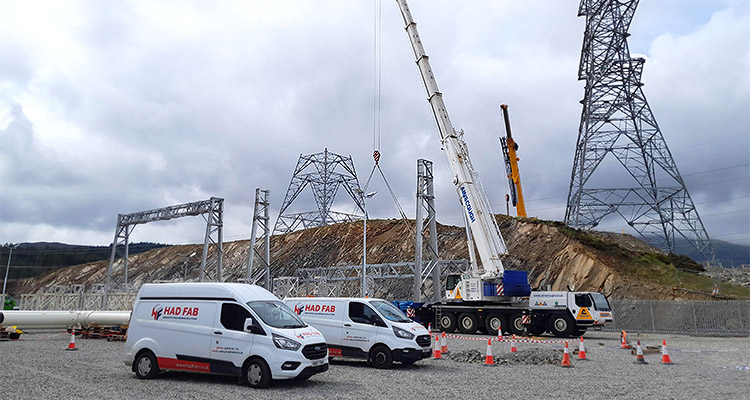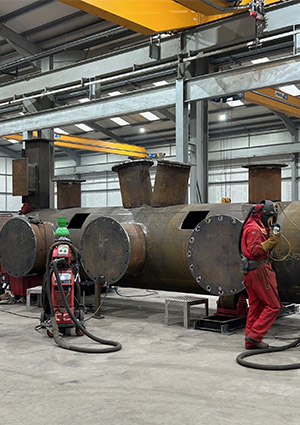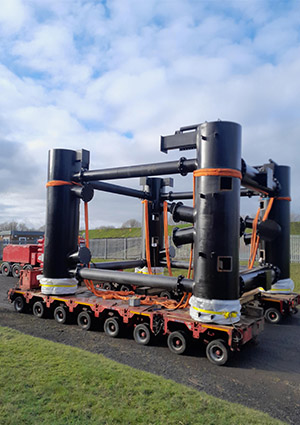
Had Fab is investing heavily in new processing equipment and facilities to meet rising demand in the power sector
Had Fab was founded by Jane and Simon Harrison in 1993. Managing Director, Greg Scott, shares an overview of the business: “We are focused on the power transmission and distribution market, which is our biggest market sector. We also have products and services available in the rail industry and are developing a growing presence in the structures associated with the transmission and distribution industry. For example, we’re starting to establish a foothold in certain buildings that house electrical equipment at substation sites. Alongside our transmission towers and associated products and services, we are actively diversifying our product offerings. For instance, we also provide the design, installation, and manufacturing of substations.
“The transmission and distribution sector accounts for around 85 per cent of our revenue, and it’s predominantly an even split between transmission towers and substations in that sector. Currently, we do nearly all of our business within the UK, although some of our products have ended up in Scandinavia through our clients. We are now receiving inquiries from Europe regarding potential export markets. While we’re not big in exports at the moment, that could present some interesting opportunities in the years to come.
substations in that sector. Currently, we do nearly all of our business within the UK, although some of our products have ended up in Scandinavia through our clients. We are now receiving inquiries from Europe regarding potential export markets. While we’re not big in exports at the moment, that could present some interesting opportunities in the years to come.
Building capacity
“We are seeing a tremendous amount of potential growth in the power transmission and distribution sector. The drive for renewables requires significant transmission infrastructure to bring offshore wind power and onshore wind power to the point of consumption. The current government targets for Net Zero pose considerable challenges to the supply chain and how we implement this strategy. We feel we are very well placed to serve that opportunity.”
Chief Commercial Officer, Anthony Jones, agrees: “A big part of our investment and staff development programme is focused on building that capacity. We have some fairly accurate projections about where we need to be over the next four to five years. It’s quite challenging, but also very exciting. We have already started expanding our facilities, bringing in new equipment, and training up new people, and that will continue in a staged approach as the market comes to us and we start to see firm order placements for these large contracts.”
Focus on integration
Greg goes on to share some specific details of the investments the company is making, including the acquisition of a new site: “We needed the additional space for processing angle sections. These sections make up the basic building blocks of the transmission towers and, in many cases, the substation structures as well. Substations can be constructed from steel or aluminium. One of our biggest customers SSE for example, focuses on aluminium structures for substations.
“For the angle lines, we work with an Italian company, Ficep, which is our machine supplier. We spent nearly £2 million installing two new state-of-the-art angle processing lines. These were installed towards the end of last year and are already proving to be a valuable asset. They operate twice as fast as our other machines. With our staged investment program, as our capacity demands reach specific trigger points, we’ll start to line these machines up so that we can increase our overall capacity flowing through the factory.
 “We also have a major programme upgrading our ERP system. When Anthony came into the business, he did a great job of establishing a digital CRM system that allows us to track all of our opportunities and the financial and commercial performance of the business. Following on from that, we needed a more integrated series of systems to process the manufacturing side and also the financial reporting side. We’ve really been expanding our capabilities in that space because we survived for long enough on homegrown tools and spreadsheets; the business was just getting too big and too sophisticated to continue like that. So, we began a major push to become more integrated across the enterprise.
“We also have a major programme upgrading our ERP system. When Anthony came into the business, he did a great job of establishing a digital CRM system that allows us to track all of our opportunities and the financial and commercial performance of the business. Following on from that, we needed a more integrated series of systems to process the manufacturing side and also the financial reporting side. We’ve really been expanding our capabilities in that space because we survived for long enough on homegrown tools and spreadsheets; the business was just getting too big and too sophisticated to continue like that. So, we began a major push to become more integrated across the enterprise.
“These systems and the data they provide give us a much clearer understanding of how the business is performing and where we have efficiency opportunities. If we are not on track to meet a production target, for example, we can easily see what we need to do about it. All of that can be done in a more proactive way with these types of systems. It is definitely essential for us moving forward.”
Alongside investments in equipment, technology, and infrastructure, Had Fab is also focusing on its human capital. Greg explains: “The investment in culture and people is really important to us. Getting the right skills in the right quantity is quite a challenge for us. So, we continue to invest in the people we have, both from a development and retention perspective.”
Emerging opportunities
Greg then concludes by highlighting the company’s ambitions for the coming years: “There is massive growth predicted in transmission and distribution, as well as the infrastructure components of the net-zero initiatives. We are investing in a more diversified portfolio; although our core market is very buoyant, we don’t want to have all our eggs in one basket. We have significant opportunities that we are pursuing. For example, we have a framework with Network Rail and will be expanding into on-site structure buildings for substations and have already completed some of these projects. We will also continue to deliver civil infrastructure solutions. Getting the balance right will be key for us. We have invested heavily in ourselves and our infrastructure to capitalize on emerging opportunities. As the core business grows organically, we want to expand our offerings across those markets and also in adjacent sectors.”